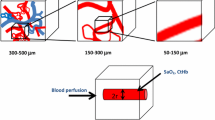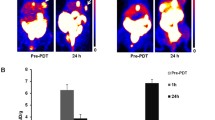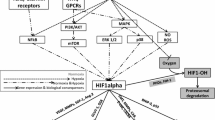Abstract
Molecular imaging of tissue hypoxia generates contrast in hypoxic areas by applying hypoxia-specific tracers in organisms. In cancer tissue, the injected tracer needs to be transported over relatively long distances and accumulates slowly in hypoxic regions. Thus, the signal-to-background ratio of hypoxia imaging is very small and a non-specific accumulation may suppress the real hypoxia-specific signals. In addition, the heterogeneous tumor microenvironment makes the assessment of the tissue oxygenation status more challenging. In this study, the diffusion potential of oxygen and of a hypoxia tracer for 4 different hypoxia subtypes: ischemic acute hypoxia, hypoxemic acute hypoxia, diffusion-limited chronic hypoxia and anemic chronic hypoxia are theoretically assessed. In particular, a reaction-diffusion equation is introduced to quantitatively analyze the interstitial diffusion of the hypoxia tracer [18F]FMISO. Imaging analysis strategies are explored based on reaction-diffusion simulations. For hypoxia imaging of low signal-to-background ratio, pharmacokinetic modelling has advantages to extract underlying specific binding signals from non-specific background signals and to improve the assessment of tumor oxygenation. Different pharmacokinetic models are evaluated for the analysis of the hypoxia tracer [18F]FMISO and optimal analysis model were identified accordingly. The improvements by model-based methods for the estimation of tumor oxygenation are in agreement with experimental data. The computational modelling offers a tool to explore molecular imaging of hypoxia and pharmacokinetic modelling is encouraged to be employed in the corresponding data analysis.
Access this chapter
Tax calculation will be finalised at checkout
Purchases are for personal use only
Similar content being viewed by others
References
Vaupel P, Kallinowski F, Okunieff P (1989) Blood flow, oxygen and nutrient supply, and metabolic microenvironment of human tumors: a review. Cancer Res 49:6449–6465
Bayer C, Shi K, Astner ST et al (2011) Acute versus chronic hypoxia: why a simplified classification is simply not enough. Int J Radiat Oncol Biol Phys 80:965–968
Koh WJ, Rasey JS, Evans ML et al (1992) Imaging of hypoxia in human tumors with [18F]Fluoromisonidazole. Int J Radiat Oncol Biol Phys 22:199–212
Rasey JS, Koh WJ, Evans ML et al (1996) Quantifying regional hypoxia in human tumors with positron emission tomography of [18F]Fluoromisonidazole: a pretherapy study of 37 patients. Int J Radiat Oncol Biol Phys 36:417–428
Souvatzoglou M, Grosu AL, Röper B et al (2007) Tumour hypoxia imaging with [18F]FAZA PET in head and neck cancer patients: a pilot study. Eur J Nucl Med Mol Imaging 34:1566–1575
Lewis JS, Herrero P, Sharp TL et al (2002) Delineation of hypoxia in canine myocardium using PET and copper(II)-diacetyl-bis(N(4)-methylthiosemicarbazone). J Nucl Med 43:1557–1569
Thorwarth D, Eschmann SM, Paulsen F et al (2005) A kinetic model for dynamic [18F]FMISO PET data to analyse tumour hypoxia. Phys Med Biol 50:2209–2224
Maftei CA, Bayer C, Shi K et al (2011) Changes in the fraction of total hypoxia and hypoxia subtypes in human squamous cell carcinomas upon fractionated irradiation: evaluation using pattern recognition in microcirculatory supply units. Radiother Oncol 101:209–216
Kelly CJ, Brady M (2006) A model to simulate tumour oxygenation and dynamic [18F]FMISO PET data. Phys Med Biol 51:5859–5873
Wang Q, Vaupel P, Ziegler SI et al (2015) Exploring the quantitative relationship between metabolism and enzymatic phenotype by physiological modeling of glucose metabolism and lactate oxidation in solid tumors. Phys Med Biol 60:2547–2571
Secomb TW, Hsu R, Dewhirst MW et al (1993) Analysis of oxygen transport to tumor tissue by microvascular networks. Int J Radiat Oncol Biol Phys 25:481–489
Pogue BW, Paulsen KD, O'Hara JA et al (2001) Estimation of oxygen distribution in RIF-1 tumors by diffusion model-based interpretation of pimonidazole hypoxia and Eppendorf measurements. Radiat Res 155:15–25
Dasu A, Toma-Dasu I, Karlsson M (2003) Theoretical simulation of tumour oxygenation and results from acute and chronic hypoxia. Phys Med Biol 48:2829–2842
Petit SF, Dekker AL, Seigneuric R et al (2009) Intra-voxel heterogeneity influences the dose prescription for dose-painting with radiotherapy: a modelling study. Phys Med Biol 54:2179–2196
Mönnich D, Troost EG, Kaanders JH et al (2011) Modelling and simulation of [18F]Fluoromisonidazole dynamics based on histology-derived microvessel maps. Phys Med Biol 56:2045–2057
Huang SC (2008) Role of kinetic modeling in biomedical imaging. J Med Sci 28:57–63
Gunn RN, Gunn SR, Cunningham VJ (2001) Positron emission tomography compartmental models. J Cereb Blood Flow Metab 21:635–652
Casciari JJ, Graham MM, Rasey JS (1995) A modeling approach for quantifying tumor hypoxia with [18F]fluoromisonidazole PET time-activity data. Med Phys 22:1127–1139
Cho H, Ackerstaff E, Carlin S et al (2009) Noninvasive multimodality imaging of the tumor microenvironment: registered dynamic magnetic resonance imaging and positron emission tomography studies of a preclinical tumor model of tumor hypoxia. Neoplasia 11:247–259
Vaupel PW, Frinak S, Bicher HI (1981) Heterogeneous oxygen partial pressure and pH distribution in C3H mouse mammary adenocarcinoma. Cancer Res 41:2008–2013
Bartlett RM, Beattie BJ, Naryanan M et al (2012) Image-guided pO2 probe measurements correlated with parametric images derived from [18F]Fluoromisonidazole small-animal PET data in rats. J Nucl Med 53:1608–1615
Acknowledgments
This study was supported by the German Research Foundation (DFG), Collaborative Research Centre (SFB) 824.
Author information
Authors and Affiliations
Corresponding author
Editor information
Editors and Affiliations
Rights and permissions
Copyright information
© 2016 Springer International Publishing Switzerland
About this paper
Cite this paper
Shi, K., Ziegler, S.I., Vaupel, P. (2016). Molecular Imaging of Tumor Hypoxia: Existing Problems and Their Potential Model-Based Solutions. In: Luo, Q., Li, L., Harrison, D., Shi, H., Bruley, D. (eds) Oxygen Transport to Tissue XXXVIII. Advances in Experimental Medicine and Biology, vol 923. Springer, Cham. https://doi.org/10.1007/978-3-319-38810-6_12
Download citation
DOI: https://doi.org/10.1007/978-3-319-38810-6_12
Published:
Publisher Name: Springer, Cham
Print ISBN: 978-3-319-38808-3
Online ISBN: 978-3-319-38810-6
eBook Packages: Biomedical and Life SciencesBiomedical and Life Sciences (R0)




